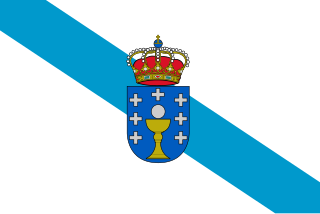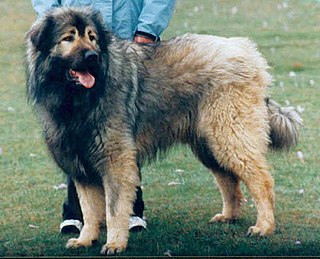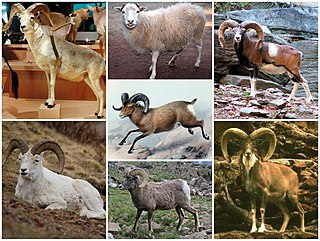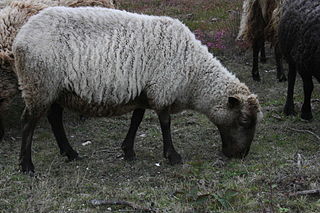
Galicia is an autonomous community of Spain and historic nationality under Spanish law. Located in the northwest Iberian Peninsula, it includes the provinces of A Coruña, Lugo, Ourense and Pontevedra.

The Bovidae comprise the biological family of cloven-hoofed, ruminant vertebrates that includes bison, African buffalo, water buffalo, antelopes, sheep, goats, muskoxen, and domestic cattle. A member of this family is called a bovid. With 143 extant species and 300 known extinct species, the family Bovidae consists of eight major subfamilies apart from the disputed Peleinae and Pantholopinae. The family evolved 20 million years ago, in the early Miocene.

The Šarplaninac, formerly also known as Illyrian Shepherd Dog, is a dog breed of the livestock guardian type. It is named after the Šar Mountains, a mountain range in the Balkans that extends from the northwestern part of North Macedonia over to Kosovo and to northeastern Albania. In Ottoman times, the dogs of the breed spent the summer in the area of the Šar Mountains and the winter in Thessaly, depending on the needs of the sheep they are used to protect.

The Galician Nationalist Bloc is a political alliance of left-wing Galician nationalist parties. It is self-defined as a "patriotic front".

The Manx Loaghtan ( loch-tan) is a rare breed of sheep native to the Isle of Man. It is sometimes spelled as Loaghtyn or Loghtan. The sheep have dark brown wool and usually four or occasionally six horns.

The Galician or Galician Mountain Horse, Spanish: Caballo de Pura Raza Gallega, Galician: Raza Equina Cabalo Galego do Monte, is a breed of small horse from Galicia, in north-western Spain. It is genetically very close to the Garrano breed of northern Portugal. It was in the past used as a war-horse and in agriculture; it is now raised principally for meat. The horses are bay or black.

Ovis is a genus of mammals, part of the Caprinae subfamily of the ruminant family Bovidae. Its seven highly sociable species are known as sheep. Domestic sheep are members of the genus, and are thought to be descended from the wild mouflon of central and southwest Asia.
Reintegrationism is the linguistic and cultural movement in Galicia which advocates for the unity of Galician and Portuguese as a single language. In other words, the movement postulates that Galician and Portuguese languages did not only share a common origin and literary tradition, but that they are in fact variants of the same language even today. According to this, Galicia should re-integrate into the Community of Portuguese Language Countries.

Galicians are a Celtic-Romance ethnic group, closely related to the Portuguese people, and whose historic homeland is Galicia, in the north-west of the Iberian Peninsula. Two Romance languages are widely spoken and official in Galicia: the native Galician and Spanish.
Fillos de Galicia is a web portal and virtual community that focuses on the Galician culture and diaspora. The site focuses on promoting unity between Galicians and the Galician diaspora. The community is a hub provides information about the Galician language or finding relatives in Galicia using the Atopadoiro. Fillos.org is one of the most popular websites regarding Galicia and its diaspora.

Galician nationalism is a form of nationalism found mostly in Galicia, which asserts that Galicians are a nation and that promotes the cultural unity of Galicians. The political movement referred to as modern Galician nationalism was born at the beginning of the twentieth century from the idea of Galicianism.

The Portland is a sheep breed that takes its name from the Isle of Portland in Dorset, England. This breed is raised primarily for meat.

Welsh Mountain sheep are small, hardy sheep from the higher parts of the Welsh mountains. The males have horns, and the females are polled (hornless); they have no wool on the face or legs, and they have long tails. There are a number of varieties, bred for sheep farming in Wales. These are mainly colour variations, but some are being developed as separate breeds.

The golden takin is an endangered goat-antelope, native to the Qin Mountains in China's southern Shaanxi province. Golden takins have unique adaptations that help them stay warm and dry during the bitter cold of winter in the rugged Himalayan Mountains. Their large, moose-like snout has large sinus cavities that heats inhaled air, preventing the loss of body heat during respiration. A thick, secondary coat is grown to keep out the cold of the winters and provide protection from the elements.
The Partido Galeguista was a Galician nationalist party founded in December 1931. It achieved notoriety during the time of the Spanish Second Republic. The PG grouped a number of historical Galician intellectuals, and was fundamental in the elaboration of the Galician Statute of Autonomy.

The Northern European short-tailed sheep are a group of traditional sheep breeds or types found in northern Europe, mainly in the British Isles, Scandinavia, Greenland and the area around the Baltic. They are thought to be derived from the first sheep brought to Europe by early farmers, and for thousands of years they were the only type of sheep kept in northern Europe. They are hardy sheep, adapted to harsh environments, but they are small and have been replaced in most areas with later types of larger, long-tailed sheep.

Siareiras Galegos is a group of fans of the Galician national football team, born in the mid-1990s.

Galician is an Indo-European language of the Western Ibero-Romance branch. It is spoken by some 2.4 million people, mainly in Galicia, an autonomous community located in northwestern Spain, where it is co-official with Spanish. The language is also spoken in some border zones of the neighboring Spanish regions of Asturias and Castile and León, as well as by Galician migrant communities in the rest of Spain, in Latin America including Puerto Rico, the United States, Switzerland and elsewhere in Europe.

The Galician goat is a breed of goat of Galician origin. In 2012, there were 622 goats in the herd as a whole, spread across 64 farms. They are very well-adapted to their environment, and, according to Invesaga, they have a better immune resistance to the common liver worm than other types of goat.
The Perdigueiro Galego is a rare breed of pointer from the autonomous community of Galicia in north-western Spain. It is one of four traditional breeds of the region, the others being the Can de Palleiro, the Guicho or Quisquelo, and the Podengo Galego.















